Treating Problems In Apricots: Learn About Diseases Of Apricot Trees


Not just any gardener has an apricot tree in their landscape, but if you do, you probably went to a lot of trouble to find it and plant it in just the right place. But would you know how to identify apricot tree diseases? Keep reading to learn about treating problems in apricots, including bacterial canker, eutypa dieback, phytophthora, ripe fruit rot, and shot hole disease.
Common Types of Apricot Disease
There are many types of apricot disease, though most are caused by the usual suspects - bacteria or fungus. Here are some of the most common diseases of apricot trees:
Bacterial Canker
Among the most frustrating of apricot problems, bacterial canker causes the formation of dark, sunken sores at the base of buds and randomly along trunks and limbs. Gum may weep through these wounds as the tree emerges from dormancy in the spring or the tree may die suddenly. Once a tree is infected with bacterial canker, there is very little you can do to help it, although some growers have seen limited success with high doses of copper fungicide applied at leaf drop.
Eutypa Dieback
Much less common than bacterial canker, eutypa dieback, also known as gummosis or limb dieback, causes sudden wilt in apricots during late spring or summer. The bark is discolored and weepy, but unlike in bacterial canker, the leaves remain attached to diseased or dead limbs. Eutypa dieback can be pruned out of trees after harvest. Be sure to remove at least 1 foot (30 cm.) of healthy tissue along with the diseased limb and treat the pruning wounds with a general purpose fungicide.
Phytophthora
Phytophthora occurs primarily in gardens where the drainage is poor or plants are chronically over watered. Roots and crowns are damaged to varying degrees, but seriously injured apricot trees may collapse soon after the first stretch of warm weather of the year. Chronic infections cause reduced vigor and early leaf fall, as well as general unthriftiness. If your tree survives the first flush of spring, spray the leaves with phosphorus acid or mefenxam and correct the drainage issue, but know it may be too late to save your apricot.
Ripe Fruit Rot
Also known simply as brown rot, ripe fruit rot is one of the more frustrating of the diseases of apricot trees. As fruits ripen, they develop a small, brown, water-soaked lesion that quickly spreads, ruining the entire fruit. Soon, tan to gray spores appear on the fruit's surface, spreading the disease further. Ripe fruit rot may also manifest as blossom or twig blight or branch cankers, but the fruit rotting form is most common. Once ripe fruit rot has taken hold, there's nothing you can do for that harvest but remove infected fruits. Clean up all fallen debris and remove any fruits that remain on and around the tree at the end of the season, then start pretreating your tree on a schedule, beginning in spring. Fungicides like fenbuconazole, pyraclostrobin, or fenhexamid are often used to protect fruits from ripe fruit rot.
Shot Hole Disease
Apricots with small, circular, purple spots on their leaves may be infected with shot hole disease. The spots sometimes dry out and fall through, but infected leaves rarely die or fall from the tree. Spots may also appear on fruits before scabbing over - if these scabs fall off, rough areas are left behind. A single application of fungicide during the dormant season may be enough to protect apricots from shot hole disease. A bordeaux mixture or fixed copper spray can be applied to dormant trees, or use ziram, chlorothalonil or azoxystrobin on blooming or fruiting trees that are showing signs of shot hole disease.
Sign up for the Gardening Know How newsletter today and receive a free copy of our e-book "How to Grow Delicious Tomatoes".

Kristi Waterworth was a regular contributor to Gardening Know How for many years, answering countless queries on plant pests and diseases.